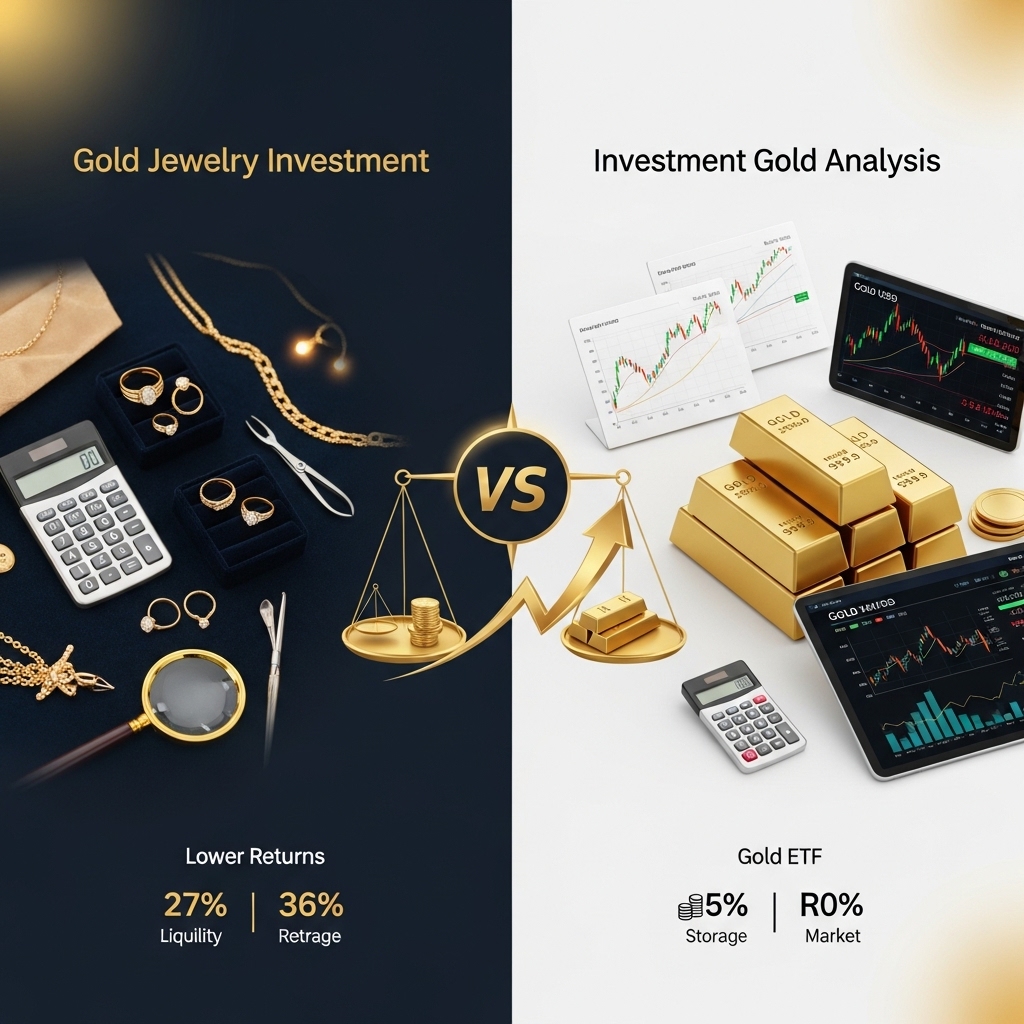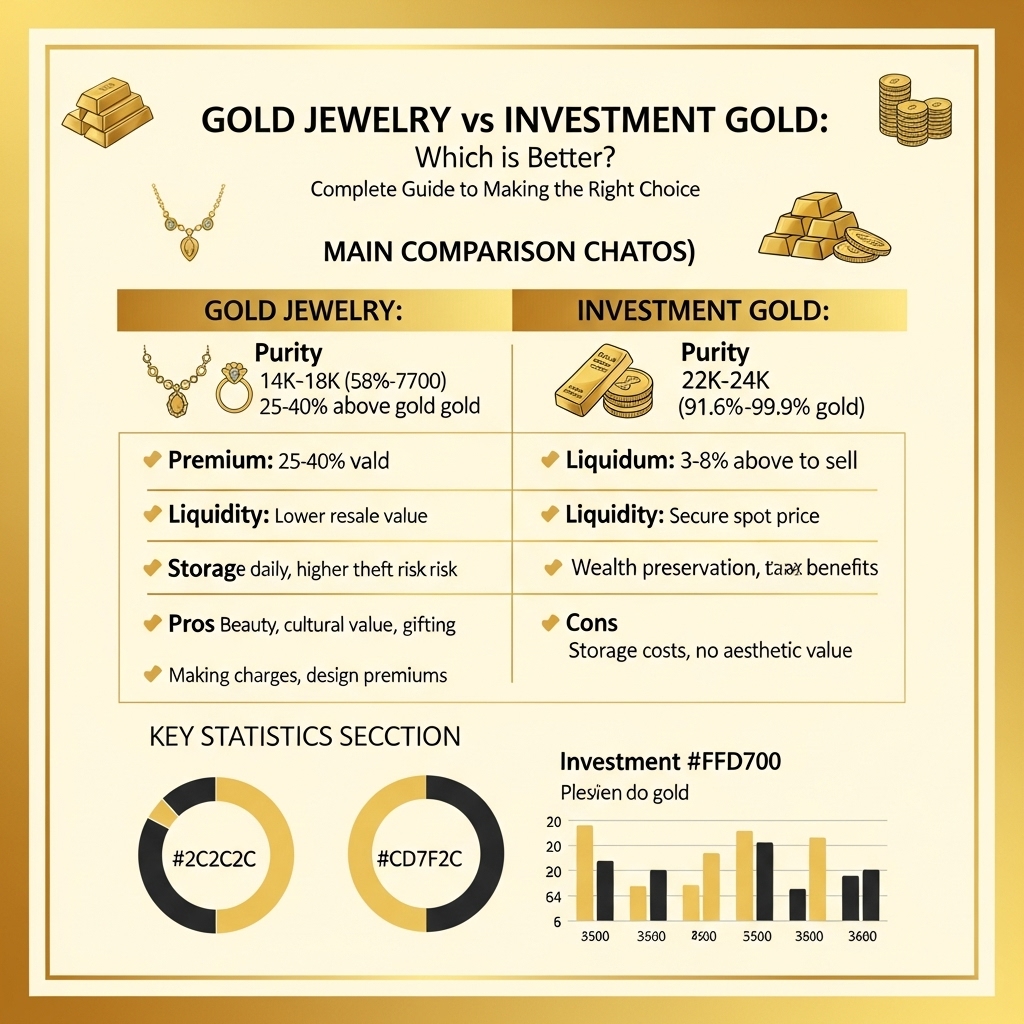Gold Jewelry vs Investment Gold: Making the Smart Choice for Your Portfolio
With gold prices surging to near-record highs in 2024, reaching over $2,400 per ounce at peak levels, investors are scrambling to capitalize on the precious metal’s remarkable bull run. But here’s the million-dollar question that’s dividing the gold investment community: should you be buying that stunning 24-karat necklace or sticking with traditional investment-grade bullion? The answer could significantly impact your portfolio’s performance and your wealth-building strategy.
This comprehensive analysis will dissect the critical differences between gold jewelry and investment gold, examining everything from premium costs and liquidity to storage requirements and long-term appreciation potential. We’ll explore how market dynamics affect each option differently, dive into the hidden costs that can erode your returns, and reveal which approach aligns best with various investment goals and risk tolerances.
For serious gold investors, this isn’t just about personal preference—it’s about maximizing returns while minimizing unnecessary expenses. With inflation concerns persisting and geopolitical tensions driving safe-haven demand, understanding the nuances between decorative gold and investment-grade gold has never been more crucial. Whether you’re a seasoned precious metals investor or just beginning to explore gold’s portfolio diversification benefits, the insights ahead will help you make informed decisions that could save you thousands of dollars and optimize your precious metals allocation strategy.
Gold Market Analysis and Key Insights
Current Market Performance and Trends
Gold prices have demonstrated remarkable resilience in 2024, reaching new all-time highs above $2,400 per ounce. The precious metal has outperformed many traditional assets, driven by central bank purchasing, geopolitical uncertainties, and persistent inflation concerns. Investment gold continues to attract institutional and retail investors seeking portfolio diversification and wealth preservation.
Recent data shows global gold demand increased by 8% year-over-year, with investment demand accounting for approximately 25% of total consumption. Exchange-traded funds (ETFs) and physical gold holdings have expanded significantly, reflecting growing investor confidence in gold as a strategic asset.
Investment Benefits and Strategic Advantages
Investment gold offers several compelling advantages over jewelry. Pure gold bullion and coins provide direct exposure to gold prices without manufacturing premiums or design markups that jewelry carries. Investment-grade gold typically trades closer to spot prices, ensuring better liquidity and more transparent pricing.
Physical gold serves as an effective hedge against currency devaluation and market volatility. Unlike jewelry, investment gold requires minimal storage considerations and offers easier authentication through recognized dealers and certification programs.
Risk Considerations and Market Dynamics
Investment gold faces certain challenges, including storage costs, insurance requirements, and potential tax implications. Price volatility can impact short-term returns, making gold more suitable for long-term investment strategies. Additionally, gold generates no income or dividends, relying solely on price appreciation for returns.
Expert Recommendations
Financial advisors typically recommend allocating 5-10% of investment portfolios to gold, emphasizing dollar-cost averaging for consistent exposure. Reputable dealers, certified coins, and established ETFs provide the most reliable investment vehicles.
For investors prioritizing pure financial returns and portfolio diversification, investment gold clearly outperforms jewelry. However, investors should consider their risk tolerance, investment timeline, and overall financial objectives when determining optimal gold allocation strategies within their broader investment portfolio.

Gold Investment Strategies and Options
When considering gold investments, investors have multiple avenues beyond traditional jewelry, each serving different strategic purposes and risk profiles.
Investment Gold Options
Physical gold investments include bullion bars, coins, and rounds, offering direct ownership with maximum control. Gold ETFs provide market exposure without storage concerns, while gold mining stocks offer leveraged exposure to gold prices but carry additional company-specific risks. Gold futures and options appeal to sophisticated investors seeking short-term price movements.
Portfolio Allocation and Risk Assessment
Financial advisors typically recommend 5-10% gold allocation for portfolio diversification. Investment-grade gold maintains consistent purity and liquidity, unlike jewelry which carries craftsmanship premiums and style depreciation risks. Physical gold serves as an inflation hedge and crisis insurance, while paper gold investments offer easier trading but counterparty risks.
Strategic Comparison
Gold jewelry combines investment with utility but typically trades at 20-30% premiums over spot prices due to making charges and design costs. Investment gold products trade closer to spot prices with transparent pricing and standardized quality. Liquidity favors investment gold, as jewelry requires appraisal and may face buyer skepticism regarding purity.
Market Timing Considerations
Gold typically performs well during economic uncertainty, currency devaluation, and geopolitical tensions. Dollar-cost averaging into gold positions helps mitigate timing risks, while tactical allocation adjustments based on real interest rates and inflation expectations can enhance returns. Long-term investors benefit from gold’s portfolio insurance properties, while short-term traders focus on technical indicators and macroeconomic catalysts.
Successful gold investing requires matching investment vehicles to specific objectives, whether wealth preservation, portfolio diversification, or speculative gains.
Market Performance and Outlook
Historical Performance
Over the past two decades, investment gold has consistently outperformed gold jewelry as a wealth preservation vehicle. From 2000-2023, spot gold prices increased approximately 500%, while jewelry typically retains only 60-70% of gold content value due to making charges and design premiums. Investment gold delivered average annual returns of 8-10%, compared to jewelry’s 5-7% appreciation when accounting for buy-back rates.
Current Market Conditions
As of 2024, gold trades near historic highs above $2,000 per ounce, driven by inflation concerns and geopolitical tensions. Investment gold products like ETFs and coins offer immediate liquidity with spreads of 1-3%, while jewelry faces 15-25% spreads due to retail markups. Central bank purchases reached record levels in 2022-2023, supporting price stability.
Economic Factors
Gold prices correlate inversely with real interest rates and USD strength. Key drivers include Federal Reserve policy, inflation expectations, currency debasement, and crisis-driven safe-haven demand. Supply constraints from major producers and growing Asian demand continue supporting long-term fundamentals.
Future Outlook
Analysts project gold reaching $2,300-2,500 by 2025, supported by persistent inflation and monetary uncertainty. Investment gold remains favored for pure exposure to these trends, while jewelry serves dual purposes but with lower financial efficiency. Portfolio allocation of 5-10% in investment gold is recommended for diversification benefits.
Frequently Asked Questions About Gold Investment
What’s the main difference between jewelry and investment gold?
Investment gold (bars, coins) typically contains 99.9% pure gold and trades closer to spot price. Gold jewelry contains 10-24 karat gold mixed with other metals and includes craftsmanship costs, making it more expensive per gram of actual gold content.
Which offers better returns on investment?
Investment gold generally provides better returns due to lower premiums and easier liquidity. Jewelry carries higher markups (often 25-100% above gold value) and lower resale values, making it less profitable for pure investment purposes.
How does liquidity compare between the two?
Investment gold offers superior liquidity through coin dealers, precious metals dealers, and online platforms. Jewelry requires appraisal and often sells for significantly less than purchase price due to retail markups and wear.
Are there tax differences?
In many jurisdictions, investment gold receives preferential tax treatment as a commodity investment. Jewelry may face different tax rates and capital gains treatment depending on local regulations.
What about storage and insurance costs?
Investment gold requires secure storage and insurance but offers standardized solutions. Jewelry needs similar protection but may require specialized appraisals and coverage for craftsmanship value beyond gold content.

Final Thoughts on Gold Investment
The choice between gold jewelry and investment gold ultimately depends on your primary objective. If you’re seeking pure financial returns and portfolio diversification, investment gold—particularly coins, bars, and ETFs—offers superior liquidity, lower premiums, and easier storage solutions. These options provide direct exposure to gold’s market value without the added costs of craftsmanship.
However, if you value the dual benefit of wealth preservation and personal enjoyment, high-quality jewelry from reputable sources can serve both purposes, albeit with higher premiums and resale challenges.
Our recommendation: Serious investors should prioritize investment-grade gold for 80-90% of their gold allocation, potentially adding select jewelry pieces for diversification and personal satisfaction.
Ready to start your gold investment journey? Research reputable dealers, compare premiums, and consider starting with government-minted coins or established ETFs to build your precious metals portfolio today.